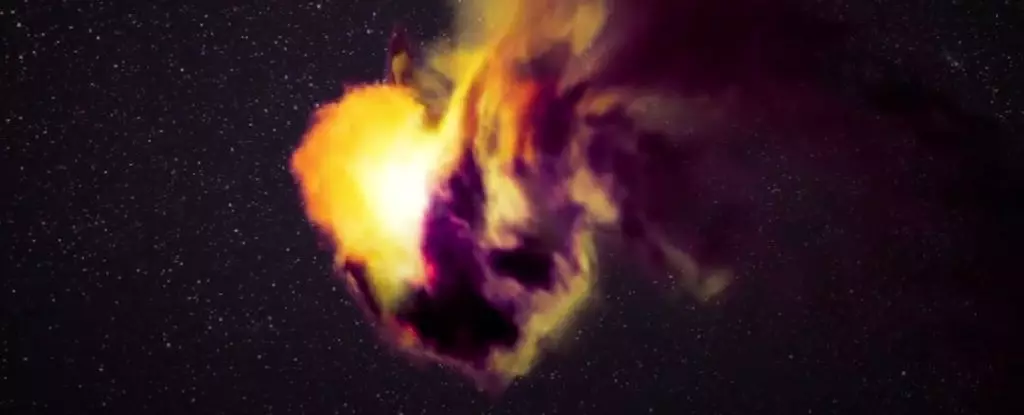The universe continues to surprise us with phenomena that challenge long-held scientific beliefs, and the recent observation of supernova SN2021yfj epitomizes this paradigm shift. Detected in 2021 at an astonishing distance of 2.2 billion light-years away, this stellar explosion defies conventional models through its unexpected elemental composition. Unlike typical supernovae that predominantly reveal lighter elements like hydrogen, helium, and some carbon and oxygen, SN2021yfj unveiled an astonishing abundance of silicon, sulfur, and argon—elements that lie deeper within the stellar structure. This discovery offers profound insights into the internal architecture of massive stars and forces astrophysicists to reconsider their models for stellar death, mass loss, and supernova mechanics.
This event is not merely an anomaly; it is a clarion call that our celestial theories might be incomplete. Does nature harbor more complex pathways for star death than previously imagined? The observations suggest so. With our existing knowledge, it was understood that massive stars develop onion-like layered structures, with lighter elements on the outside and heavier elements towards the core, culminating in iron. When these stars explode, the expectation was that the ejecta would predominantly carry signatures of the lighter, outer layers. However, SN2021yfj’s spectral composition paints a different picture—one of a star whose insides had been extensively stripped, exposing layers previously thought to be unreachable or obliterated during the final stages.
This rare glimpse into “naked” stellar cores heralds a major shift—implying that violent mass-loss episodes before a supernova are more common and more extreme than simplified models suggest. Traditional understanding assumes that by the time a star nears its catastrophic end, it retains much of its original structure, with only the outer shell having been expelled gradually through stellar winds or eruptions. Yet SN2021yfj indicates that some stars may undergo dramatic, violent shedding all the way down to their cores, potentially rooted in complex internal dynamics not fully accounted for in canonical models.
Unraveling the Mysteries of Stellar Demise
The findings revolving around SN2021yfj beckon us to reevaluate the processes governing the final stages of massive stars. Fusion inside stellar cores proceeds dynamically, creating a layered structure resembling an onion—each layer representing a different element, from hydrogen and helium to silicon, sulfur, and ultimately iron. When the star exhausts its nuclear fuel, the core collapses, igniting a supernova that should reveal these distinct inner regions predominantly through its spectral signatures.
However, what makes SN2021yfj extraordinary is the heavy-element-rich ejecta, indicating that the star’s outer layers were peeled away with remarkable efficiency. Could this imply the star experienced multiple, intense eruptions prior to its ultimate explosion? Or did internal instabilities cause a more tumultuous shedding of mass than previously believed? The salient question revolves around the mechanisms propelling such violent mass ejections—something our current models only vaguely approximate.
The plausible explanation proposes that as nuclear fuel is depleted, the core contracts, heating up and reigniting fusion in an explosive feedback loop. These repeated episodes could eject substantial material, stripping the star to near its innermost layers. When the explosion finally occurs, the shockwave propagates through this dense, exposed core and then blindly pushes outward, interfacing with shells of previously expelled material, which results in the spectacular brightness and spectral compositions observed.
This theory, while compelling, remains speculative without further data. It underscores the necessity for more detailed, high-resolution observations and models that can accurately simulate such violent pre-supernova phenomena. If confirmed, it would drastically redefine the scope of stellar evolution theory, emphasizing that mass loss can be far more episodic and violent, ultimately changing the very way we interpret the cosmic death toll of these giants.
Implications for Stellar Life and the Universe’s Chemical Enrichment
The universality of supernovae as cosmic forges of heavy elements is well-established. They seed galaxies with the raw materials necessary for planet formation and life itself. Yet, SN2021yfj reveals that the enrichment process could be influenced by more tumultuous stellar histories than previously appreciated. The notion that stars can shed their outer shells aggressively and repeatedly, exposing their core layers rich in silicon, sulfur, and argon, suggests that the diversity of supernova outcomes—and by extension, the chemical composition of the universe—is even broader than our models have predicted.
Furthermore, understanding these energetic, mass-stripping episodes bears relevance on galactic evolution theories. If such behavior is more prevalent, it could influence the distribution of elements and the dynamics of supernova remnants that we observe far across the cosmos. The explosive dispersal of different layers of material might also affect the characteristics of remnants such as neutron stars or black holes, hinting that their formation could be more complex and varied than the uniform models we currently rely on.
This supernova, thus, acts as both a literal and conceptual catalyst. It prompts astrophysicists to refine internal stellar models, incorporating the possibility of more violent pre-supernova episodes. It also urges the scientific community to broaden the scope of observational strategies—seeking out the signatures of such exotic explosions and reconnecting them vividly with the lifecycle of the universe’s most massive and enigmatic stars.

